Acrylic paint is water-based and has impressive bonding qualities. So, how to remove acrylic paint from wood?
To remove acrylic paint from wood, use a warm soapy water mixture, solvent-based paint remover, sand the paint off, use a paint-stripping compound, or scrape the paint off.
To remove acrylic paint from a wooden floor, use denatured alcohol for small paint stains or a floor sander for large paint surfaces.
Can You Remove Acrylic Paint From Wood Without Sanding?
You can remove acrylic paint from wood without sanding by using a paint-stripping compound, solvent-based paint remover, or a homemade mix remover.
Paint-removing products penetrate the paint coating, dissolve the binder and the bond between paint particles, and liquefy the paint, making it easier to wipe it off.
However, paint-removing products can discolor or damage the wooden surface if left over the surface for too long.
You can remove small acrylic paint stains from wood with a mixture of vinegar, dish soap, or baking soda.
How To Remove Acrylic Paint From Wood?
To remove acrylic paint from wood, do the following things.
- Use a Warm Soapy Water Mixture.
- Use Solvent-based Paint Remover.
- Sand the Paint Finish.
- Use Paint-stripping Compound.
- Scrape the Paint Finish off.
1. Use a Warm Soapy Water Mixture
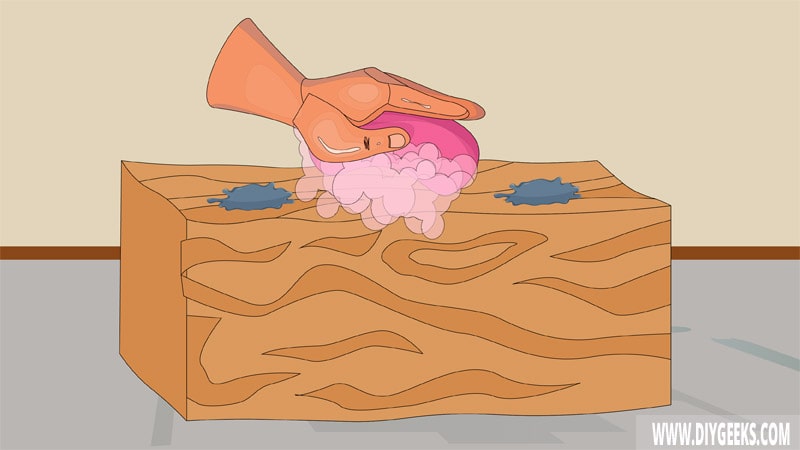
Use warm soapy water to remove small acrylic paint stains from wood. Since the acrylic paint is wet and small, warm soapy water will remove it.
The tools you need for this project are listed below.
- Dish soap
- Warm water
- A soft sponge or microfiber cloth
- A clean bowl or bucket
- A plastic putty knife or scraper
To remove small acrylic paint from wood with warm soapy water, do the following things.
- Mix warm water with dish soap.
- Pour the warm soapy water over the acrylic paint stains.
- Wait 5 minutes.
- Use a soft sponge or microfiber cloth to scrub the paint off of the wood.
- Repeat the steps above for leftover paint stains.
- Wipe the wood with a clean rag and leave it to dry.
You can’t remove multiple dried acrylic paint coats with warm soapy water.
2. Use Solvent-based Paint Remover
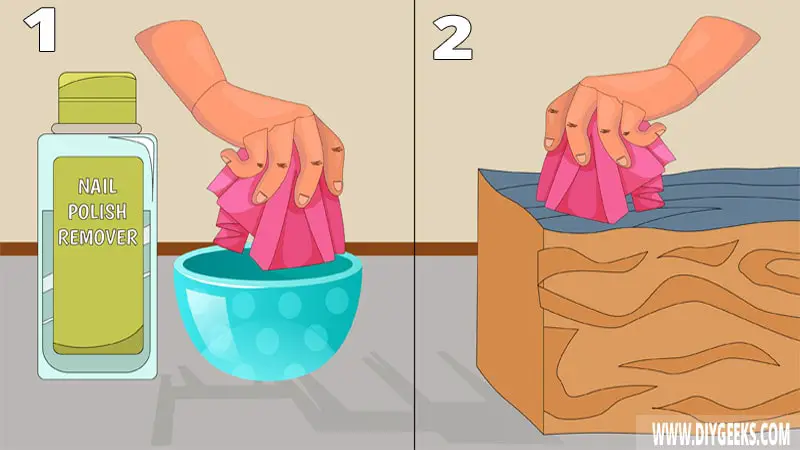
A solvent-based paint remover will penetrate the acrylic paint, dissolve the paint binder, break the bond between the particles, and liquefy the paint. Once the paint liquefies, you can scrape it off.
Use rubbing alcohol, acetone, or vinegar as a solvent-based paint remover.
The tools you need for this project are listed below.
- Rubbing alcohol or acetone.
- Vinegar or baking soda
- A plastic putty knife
- A soft sponge
- Rags
To remove acrylic paint from wood with a solvent-based paint remover, do the following things.
- Clean the acrylic paint finish.
- Damp a rag with solvent-based paint remover and use the dampened rag to wipe the paint finish.
- Wait 10 minutes.
- Use a soft sponge to scrub the paint off the wood.
- Repeat the steps for leftover acrylic paint.
- Wipe the wood with a clean rag and leave it to dry.
3. Sand the Paint Finish
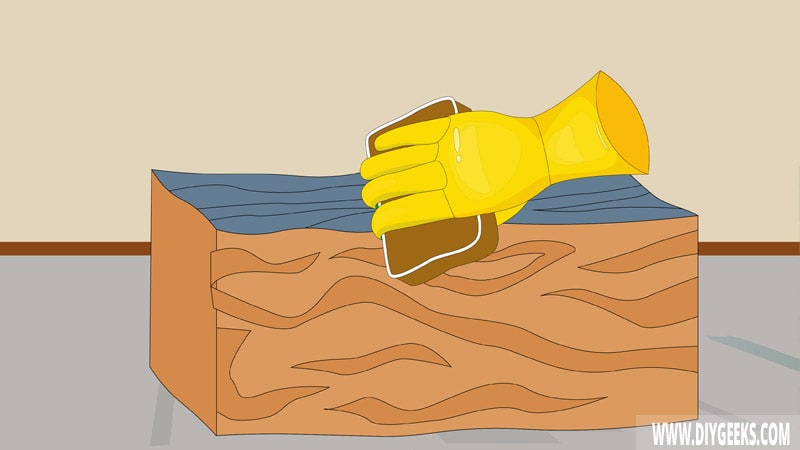
Coarse-grit sandpaper (40-grit) will remove acrylic paint from wood and smoothen the surface to make it ready for re-painting. The abrasive side of the sandpaper will gradually wear off the paint from the surface.
Don’t use fine-grit sandpaper (220-grit) as this sandpaper isn’t rough enough to wear off paint finishes.
The tools you need for this project are listed below.
- Sandpaper of different grits
- A vacuum or duster
- A power sander (if you are working on a large surface)
To sand acrylic paint off surfaces, do the following things.
- Clean the paint finish with a lint-free rag.
- Use coarse-grit sandpaper (40-grit) to sand the wood.
- Inspect the surface every five (5) minutes to see if the paint is removed.
- Use a vacuum to clean the dust.
- Use medium-grit sandpaper (100-grit) to smoothen the surface after removing it.
- Clean the wood and re-apply the paint if needed.
4. Use Paint-stripping Compound
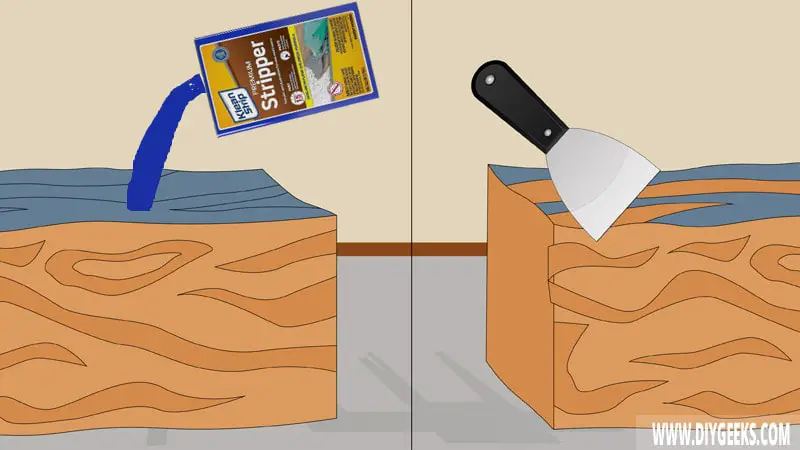
A paint-stripping compound penetrates the acrylic paint finish, breaks the adhesion between the paint and the surface, and dries underneath the paint. Once the paint-stripping compound dries, use a paint scraper to scrape it off and the paint will come off too.
The tools you need for this project are listed below.
- A paint stripper
- A putty knife
- Rags
- Paintbrushes
- Mineral spirits
Here’s a step-by-step guide.
- Wipe the acrylic paint with a rag to remove dust.
- Prep the paint stripper based on the manufacturer’s instructions.
- Apply thick coats of the paint stripper on the acrylic paint and leave for 20 minutes – you can use a paintbrush to apply the stripper.
- When the paint striper is dry, remove it with a paint scrapper – the acrylic paint will come off with it.
- Repeat the steps for leftover acrylic paint.
- When the acrylic paint has been removed, wipe down the wood with a clean rag and some mineral spirits. This helps to neutralize the paint stripper residue.
5. Scrape the Paint Finish off.
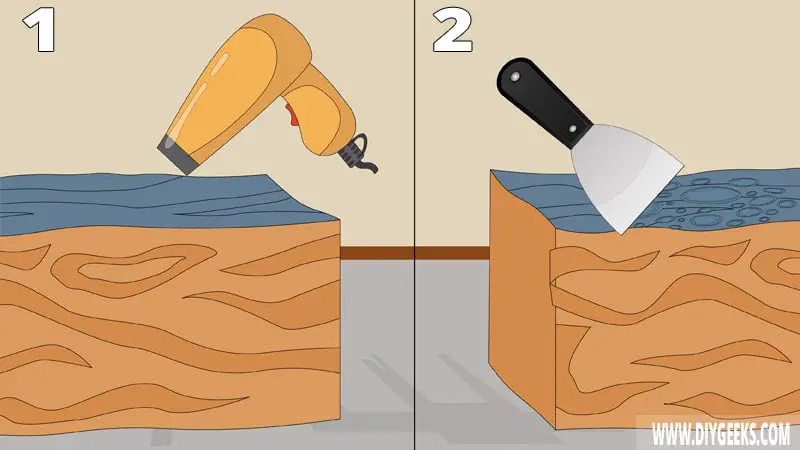
Soften the acrylic paint by exposing it to increased heat and use a paint scraper to scrape it off. To soften the paint, use a hairdryer.
The tools you need for this project are listed below.
- A hairdryer, heater, or heat gun
- Rags
- A paint scraper
To scrape acrylic paint off wood, do the following things.
- Use a hairdryer over the paint coating for less than 3 minutes.
- Move the hairdryer around the paint coating.
- Use a paint scraper to scrape the acrylic paint.
- Pause for 10-15 minutes.
- Re-use the hairdryer and scrape the paint again. Do this until all the paint is removed.
Don’t use the hairdryer for more than 3 minutes and always move it around as you can damage the wooden surface.
How To Remove Acrylic Paint From Wooden Floors?
To remove acrylic paint from wooden floors, do the following things.
- Use Denatured Alcohol (For Small Paint Stains).
- Use a Floor Sander (For Large Paint Surfaces).
1. Use Denatured Alcohol (For Small Paint Stains)
Denatured alcohol removes small water-based paint stains from different surfaces. The solvent will penetrate the paint finish and gradually dissolve it.
Don’t use denatured alcohol to remove paint from large wooden floors as it takes longer.
The tools you need for this project are listed below.
- A bottle of denatured alcohol
- Rags
- A clean plastic bowl
- Mild detergent
- A mop
- A bucket of warm water
To remove small acrylic paint from wooden floors, do the following things.
- Damp a rag with denatured alcohol.
- Use the dampened rag to wipe the small paint stains.
- Wait around 5 minutes.
- Use a clean cloth to wipe the paint stain off.
- Remove the denatured alcohol residue from the surface with clean water.
- Leave the wooden floor to dry.
2. Use a Floor Sander (For Large Paint Surfaces).
A floor sander will remove large paint finishes from wooden floors. The floor sander removes paint the same way manual sanding does — by using the abrasive side of the sandpaper to gradually wear the paint off.
Attach a coarse-grit or medium-grit sandpaper to the floor sander and use it over the floor.
The tools you need for this project are listed below.
- Coarse or medium-grit sandpaper (40/100-grit)/
- Floor Sander
- A vacuum
Here is a guide for this method:
- Clean the wooden floor to remove dust, dirt, and debris.
- Open all doors, windows, and vents for ventilation.
- Attach a coarse-grit sandpaper (40-grit) to the floor sander.
- Sand the wooden floor in circular motions.
- Inspect the floor every 5 minutes to see if the paint is removed.
- Once the paint is removed, attach medium-grit sandpaper (100-grit) to the floor sander to smoothen the floor.
- Remove dust.
- Re-paint the floor if needed.
Tip: Don’t apply pressure while sanding as you can damage the wood floor.


